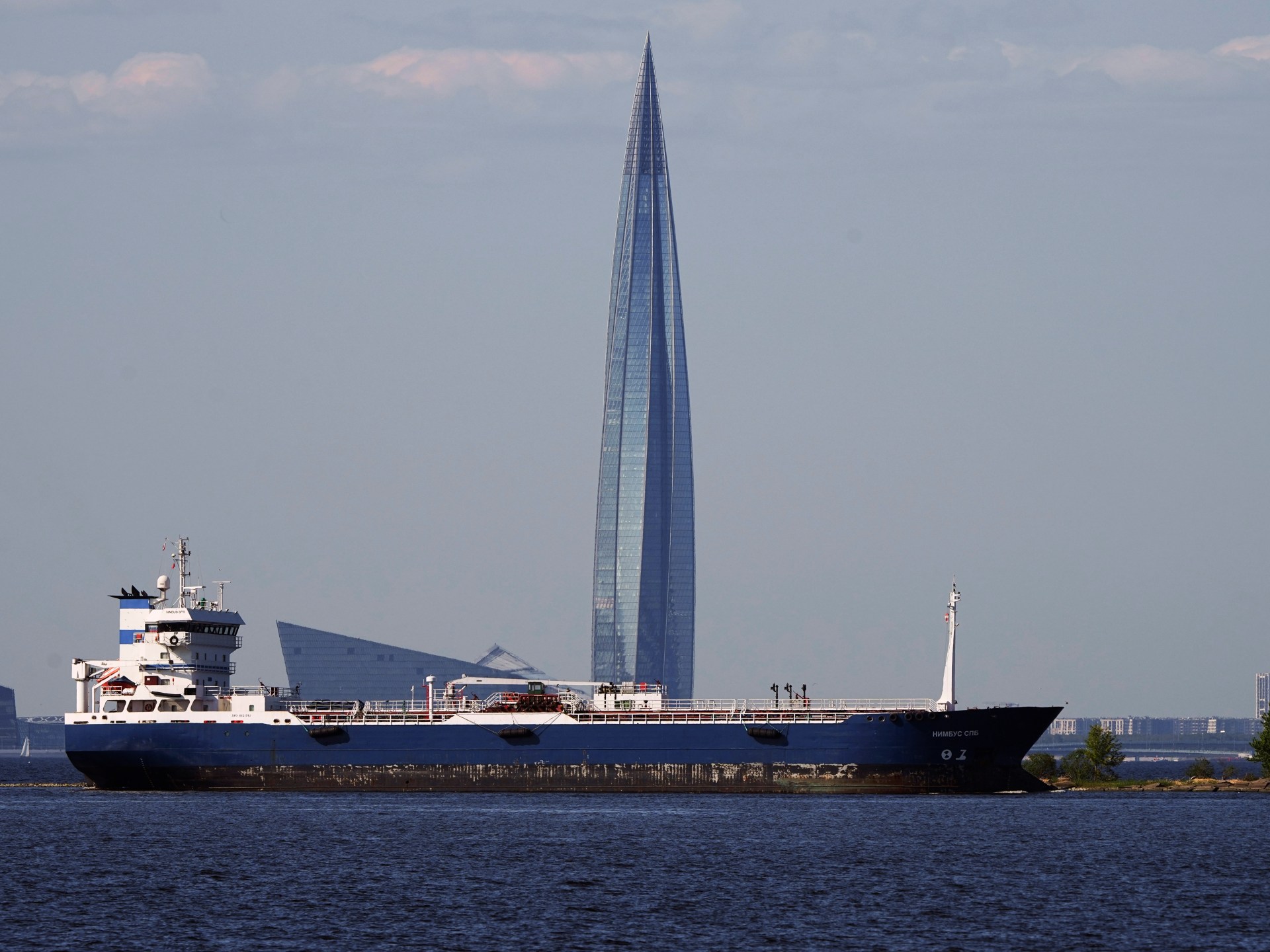The Russian tanker disaster and an oil leak in Kerch Strait: What it means | Environment News

Two Russian ships damaged in stormy weather over the weekend have spilled about 3,700 tons (3,350 tonnes) of low-grade fuel into the Kerch Strait in Russian-occupied Crimea, Russian state media reported on Monday, threatening an environmental disaster in the biodiversity hotspot.
The vessels were carrying about 9,200 tons (8,300 tonnes) of mazut – a heavy, low-quality oil product that’s mainly used in power plants. The tankers were on their way to deliver fuel for the Russian Navy amid Russia’s war on Ukraine when they got caught in the bad weather and broke apart on Sunday. At least one crew member on one of the ships died in the storm, Russian authorities said.
Environmental experts have sounded the alarm on what they say could be a difficult spill to contain as videos emerge of oil-slicked birds and stretches of blackened shorelines. Ukraine, which claims the area as its territory, has accused Moscow of violating sea regulations by using old vessels, and is calling for international sanctions on Russia.
Here’s what we know about how the disaster happened and how its occurrence during wartime could mean much worse effects for the environment.
What happened?
Two Russian tankers were damaged during a heavy storm in the Kerch Strait on Sunday, according to Russian officials.
One of them, the 133-metre-long Volgoneft 212 tanker, was carrying a crew of 15 and a cargo of fuel oil when it ran aground and its bow was ripped away by a large wave, Russia’s TASS news agency reported. On video footage posted to social media, it appeared to sink vertically into the sea. Videos also showed black streaks of oil from the tanker as the vessel sank.
Russian authorities launched a large-scale rescue operation on Sunday following the accidents. One crew member of the ship died in the storm, but a rescue team was able to evacuate the others to a clinic where they were being treated for hypothermia.
Separately, a second loaded tanker, the 132-metre-long Volgoneft 239, was damaged in the same storm on Sunday and ran aground 80 metres from shore, close to the port of Taman in Russia’s Krasnodar region. All 14 crew members from that ship were rescued.
The Kerch Strait, where the accidents occurred, separates Russian-occupied Crimea from Russia’s mainland and is an important global shipping route connecting vessels moving between the Sea of Azov and the Black Sea. The area has been a flashpoint between Russia and Ukraine since Moscow forcefully annexed Crimea from Ukraine in 2014. Kyiv has over the years accused Russia of harassing its ships and excluding local fishermen.
In 2016, Ukraine dragged Russia to the Permanent Court of Arbitration – which focuses on alternative dispute resolutions between nations – over allegations that Moscow was violating Kyiv’s coastal rights in the Black Sea, Sea of Azov, and Kerch Strait. The case is continuing and the last hearing was in September 2024.
How have Russian authorities responded to the oil spill?
On Monday, President Vladimir Putin ordered officials of the emergency and environmental ministries to handle the rescue operation and minimise damage from the fuel spill, according to spokesperson Dmitry Peskov.
Authorities have since opened two criminal cases to determine if the vessel’s crew violated safety regulations and caused the accidents. Environmental experts are also assessing the levels of environmental damage but have not yet made a report, state news media reported.
Russian authorities initially claimed the spilled oil had not reached the shore. However, by Tuesday evening, social media footage showed vast stretches of shoreline covered in oily, black mud. Footage also captured waterfowl with their bodies blackened from the oil, walking on the shorelines.
“We will remove all of this despite the fact that it seems outwardly scary from the point of view that these are petroleum products,” Veniamin Kondratyev, governor of the Krasnodar region, told reporters on Tuesday, speaking from a part of the affected shoreline. “It’s removable, everything is removable.”
What is Ukraine accusing Russia of?
Ukrainian officials have accused Moscow of recklessness for violating sea operating rules by deploying old “shadow fleet” vessels notorious for operating outside maritime laws.
Mykhailo Podolyak, an adviser to the head of the office of President Volodymyr Zelenskyy, wrote on X that the disaster was one of the worst ever recorded in the Black Sea. The affected ships, he added, were more than 50 years old and unable to withstand winter storms.
“Most of the more than a thousand tankers of the Russian ‘shadow fleet’ are hopelessly outdated, have fictitious insurance policies, conceal their true owners, and often overload oil at sea,” he said, adding that more large-scale accidents like this were “inevitable” and that neighbouring countries would bear the cost.
The politician also called for countries to ban Russian tankers from their waters.
The Russian “shadow fleet” includes an estimated 500 to 1,000 tankers which often lack proper insurance, have no clear ownership and frequently change their names and flag registrations in violation of maritime regulations, analysts have found.
The vessels engage in risky ship-to-ship transfer of cargo such as oil, allowing Russia to circumvent trade sanctions imposed by Western countries for its 2022 invasion of Ukraine according to investigations by United States think tank, the Atlantic Council. The sanctions impose a $60 per barrel cap on Russian oil, meaning even if it’s worth more, buyers in the European Union and worldwide are banned from paying more. The point is to reduce Putin’s earnings from oil.
In October 2023, two-thirds of tankers carrying Russian crude oil were listed as having “unknown” insurance, the Atlantic Council found.
Since they are often uninsured, shadow fleet vessels are poorly maintained and tend to malfunction, the think tank concluded.
On Monday, the EU blacklisted 52 vessels it said were part of Putin’s shadow fleet and involved in transporting Russian oil, military equipment and stolen Ukrainian grain. In total, 79 such vessels have been banned by the bloc since 2022.

How will the oil spill affect the environment?
The oil spill has contaminated at least 60km (37 miles) of shoreline, majorly affecting parts of Anapa, a town in the Krasnodar region, Natalia Gozak, who leads Ukraine’s branch of the environmental organisation Greenpeace, told Al Jazeera.
Several towns have declared a state of emergency because of the number of bird deaths, she said.
“Locals are already posting dozens of videos of mazut stains and birds trapped in it along the seashore near Anapa,” Gozak said. In one video published on Telegram, locals bathed a blackened bird that appeared to be a duck, in an attempt to remove the oil.
Gozak said Russia is “jeopardising” the local ecosystem with its shadow fleet vessels and said Sunday’s accident was a “warning sign” of the larger problem the vessels pose.
The area is home to several species of dolphins and birds. These animals have already been affected by chemical pollution and the impact of previous disasters, environmental researcher Aleksandar Rankovic, director of the environmental think tank The Common Initiative, told Al Jazeera.
For example, in November 2007, a Russian oil tanker crashed in the Kerch Strait and spilled between 1,200 and 1,600 tonnes of oil.
“Large amounts of heavy fuel oil mixed with algae were found on the shores, killing thousands of birds, which were the most affected organisms,” Rankovic said.
Heavy layers of oil products settled on the sea floor, destroying sea bed organisms which constitute the food base for many species of fish, gobies and mullet.
However, Rankovic said, coordination between Ukrainian and Russian experts at the time, helped ensure a joint disaster response, an approach not likely while the two are war.
“The question for me is how the current conflict will impede the swift response necessary both to prevent further leakage and quickly clean up the shores when pollution reaches them,” Rankovic said. “It is urgent to prevent further leakage, and prevent chronic leakage that could happen in the future.”

Have there been other environmental disasters amid the Russia-Ukraine war?
Yes. In June 2023, Ukraine’s Nova Kakhovka dam, located on the Dnipro River in the Ukrainian city of Kherson, was shelled.
The dam burst open and caused widespread flooding in the Russian-controlled city. Some 100,000 people were forced to leave their homes as water levels rose rapidly. Officials said about 30,000 animals were killed, and species like the squacco heron and the little egret were wiped out in what they called an “ecocide”.
Analysts estimated the immediate economic loss to Ukraine at $4bn.
The damage was likely caused by Russian forces intentionally blowing up the dam to stall a Ukrainian advance, experts said. However, Russian forces denied responsibility.
The 30-metre-high, 2km-long dam had powered a major hydroelectric power plant in the region and contained a reservoir of some 18 cubic kilometres of water supplying communities and farms. It also supplied cooling water to the nuclear power plant in Russian-controlled Zaporizhzhia.
The resulting widespread flooding wiped out the hydroelectric power plant and carried water into the homes of Kherson’s residents. People lost access to water, gas and electricity for several days.

Does the environment generally suffer more in times of war?
Yes. Armed conflict is taxing on the environment. Militaries tend to clear swaths of vegetation to remove cover where enemy fighters could be hiding. Bombs and mines contaminate the soil and waterways and emit toxic gases.
In Ukraine, large areas of land are likely contaminated because of landmines and unexploded ordnance, according to the United Nations. Clearing these land mines will likely cost the country $34.6bn.
In Gaza, the UN says the Strip’s soil and water have suffered “complete degradation” because of a combination of shelling and a collapse of the sewage and waste systems while under Israeli bombardment for the past 14 months. Millions of tonnes of debris from destroyed buildings also contain hazardous unexploded ordnance and asbestos.
Those conditions are linked to a rise in respiratory infections. In the three months following October 7, 2023, when the war on Gaza began, the World Health Organization (WHO) reported 179,000 cases of acute respiratory infection. Diarrhoea among children under the age of five is also rising, as the disease is contracted from contaminated food or water.
Most notably, Gaza recorded new cases of the deadly poliovirus in August 2024, 25 years after it was eradicated from the Strip. Medical experts say its re-emergence is directly linked to the destruction of water and sanitation infrastructure. The virus can cause irreversible paralysis in hours and a global effort to eliminate it has continued for decades.





